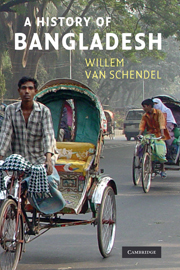Book contents
- Frontmatter
- Contents
- List of plates
- List of maps and figures
- Acknowledgements
- Timeline
- Introduction
- PART I THE LONG VIEW
- PART II COLONIAL ENCOUNTERS
- 5 From the Mughal empire to the British empire
- 6 The British impact
- 7 A closing agrarian frontier
- 8 Colonial conflicts
- 9 Towards Partition
- 10 Partition
- PART III BECOMING EAST PAKISTAN
- PART IV WAR AND THE BIRTH OF BANGLADESH
- PART V INDEPENDENT BANGLADESH
- Conclusion
- Bangladesh district maps
- Key political figures since 1947
- Glossary of Bengali terms
- Notes
- Bibliography
- Index
7 - A closing agrarian frontier
Published online by Cambridge University Press: 05 February 2015
- Frontmatter
- Contents
- List of plates
- List of maps and figures
- Acknowledgements
- Timeline
- Introduction
- PART I THE LONG VIEW
- PART II COLONIAL ENCOUNTERS
- 5 From the Mughal empire to the British empire
- 6 The British impact
- 7 A closing agrarian frontier
- 8 Colonial conflicts
- 9 Towards Partition
- 10 Partition
- PART III BECOMING EAST PAKISTAN
- PART IV WAR AND THE BIRTH OF BANGLADESH
- PART V INDEPENDENT BANGLADESH
- Conclusion
- Bangladesh district maps
- Key political figures since 1947
- Glossary of Bengali terms
- Notes
- Bibliography
- Index
Summary
When the British annexed eastern Bengal in 1757 it was largely a rural society. When they left 190 years later, it was still overwhelmingly rural – 96 per cent of all people lived in the countryside. In the meantime, however, much had changed. After the depopulation of the late eighteenth century, the more fertile eastern and southern districts supported denser populations than the western and northern ones. Towns and cities shrank as industries disappeared. Bengal's ruralisation did not stop till the mid-nineteenth century, after which towns began to grow again, but slowly. By 1901 the territory that was to become Bangladesh had 30 million inhabitants, but only 2.5 per cent (0.7 million) of them lived in towns and cities. Although by 1947 there were 42 million inhabitants, the four largest cities were small – Dhaka had about 250,000 inhabitants, Chittagong 200,000, Khulna 60,000 and Rajshahi 40,000 – and the urban population represented only 4 per cent of the total. In other words, at the end of colonial rule, almost everyone in eastern Bengal earned their living in the countryside. Most of them were engaged in agriculture.
In the colonial period the agrarian economy underwent important change. As eastern Bengal's industrial exports declined, its agrarian exports expanded. Agrarian production increased by means of a steady expansion of cultivated area rather than improved technology or higher productivity. Landlords were happy to appropriate agrarian surpluses to sustain their comfortable lifestyle but they did not invest in agriculture.
- Type
- Chapter
- Information
- A History of Bangladesh , pp. 67 - 76Publisher: Cambridge University PressPrint publication year: 2009



